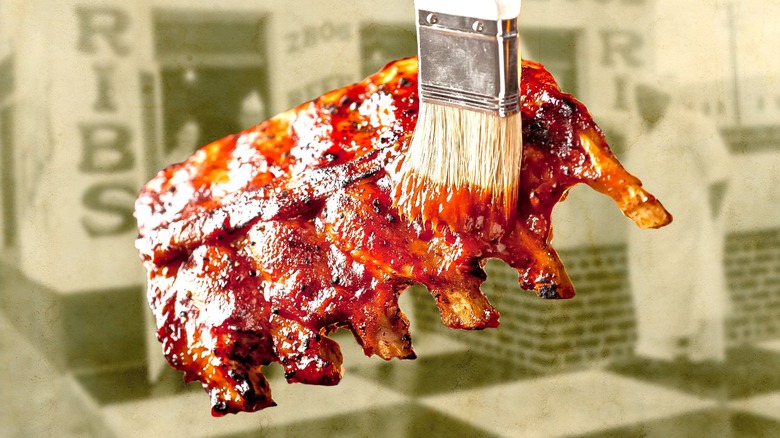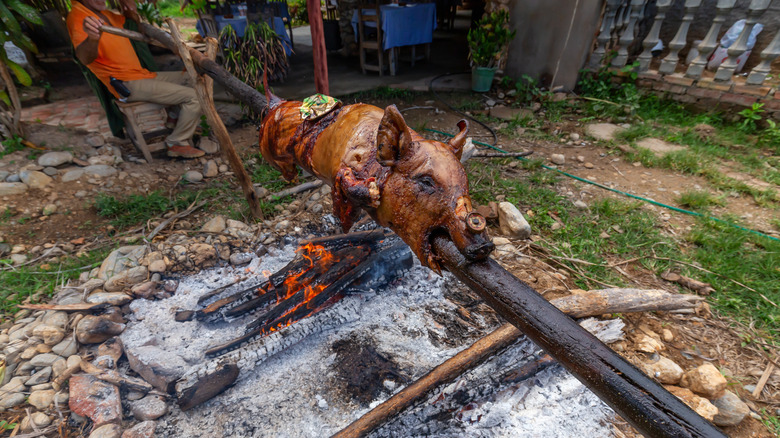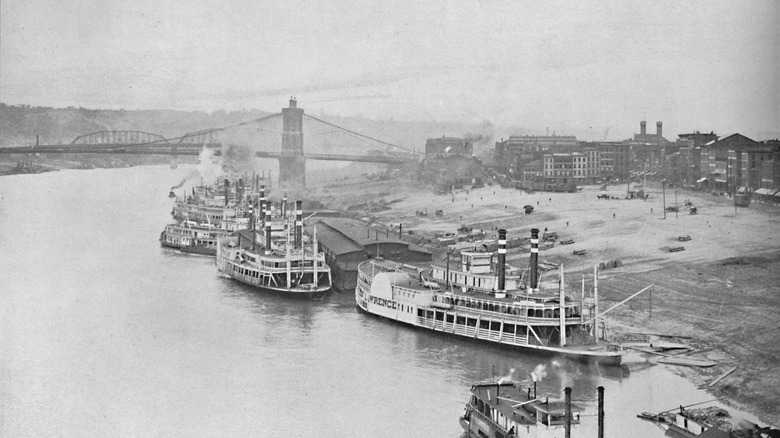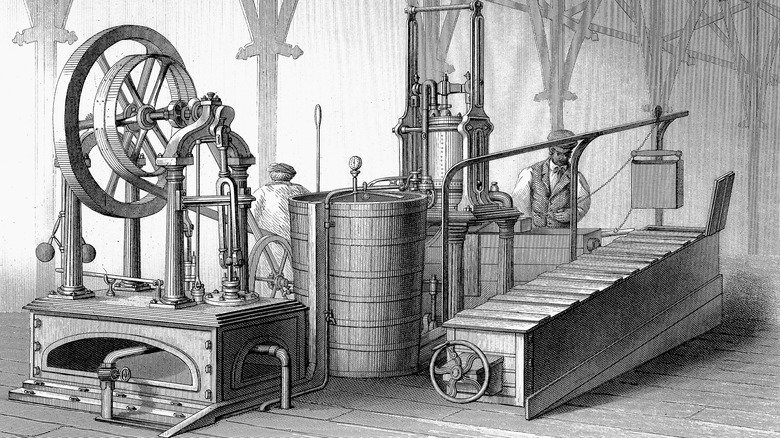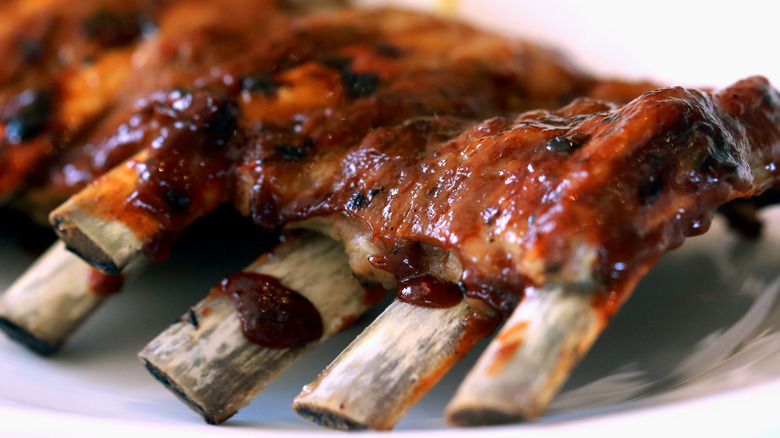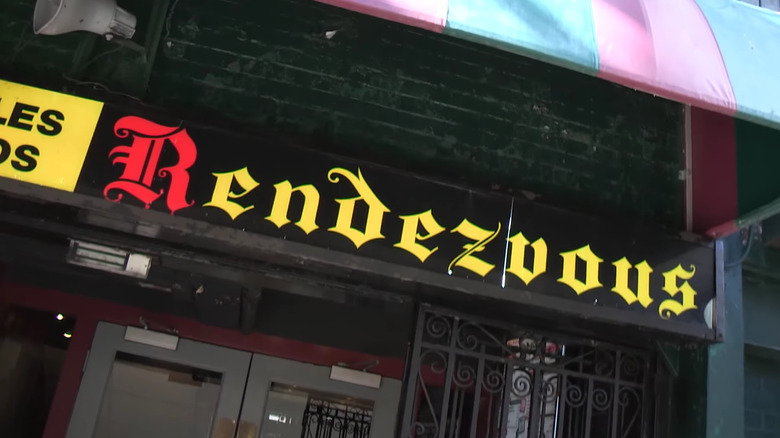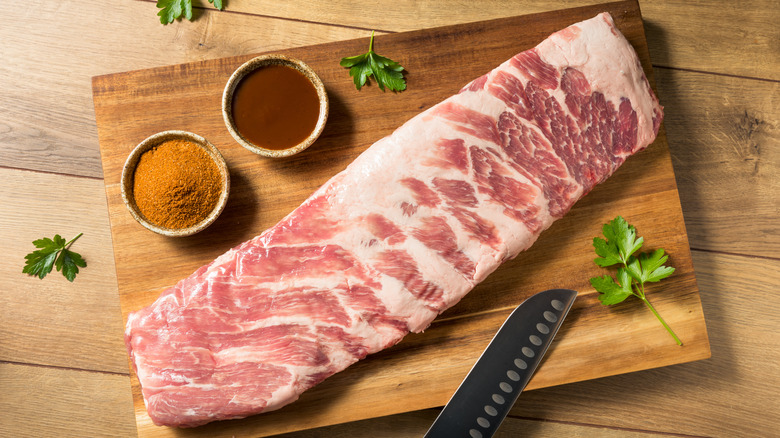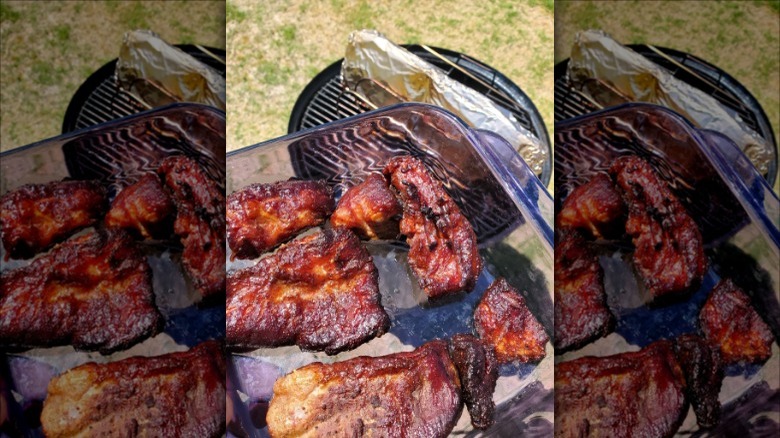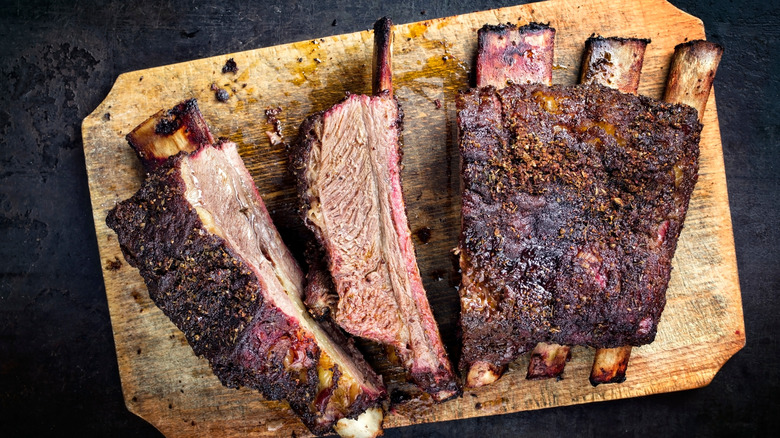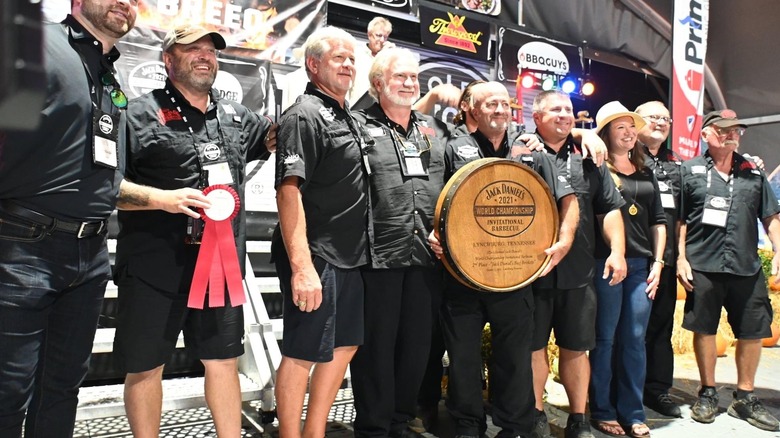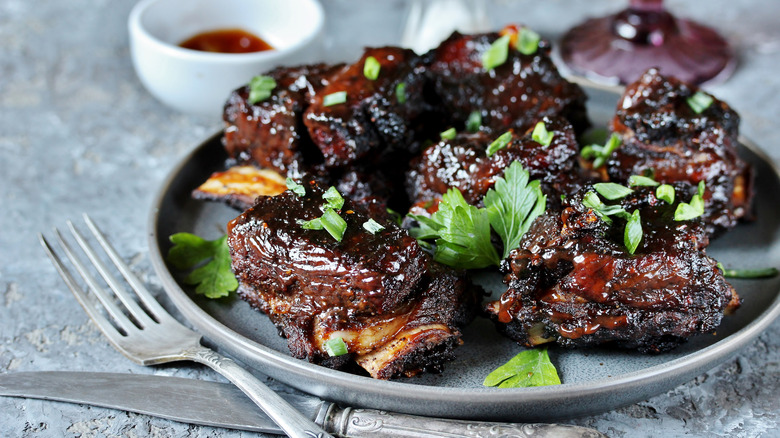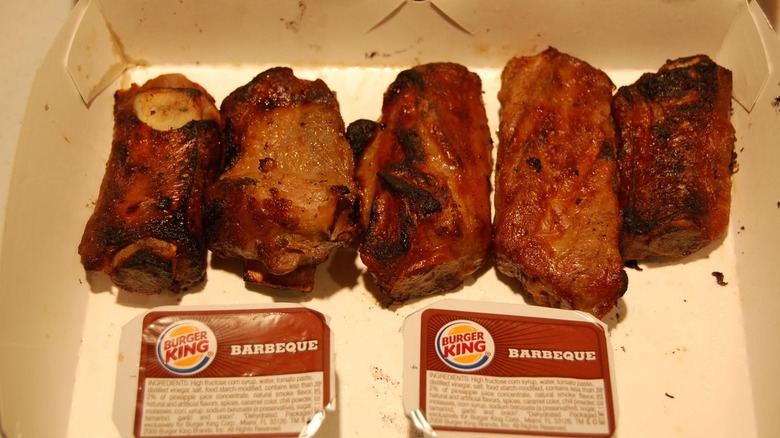The Unexpectedly Recent History Of Barbecue Ribs In America
There are few things as quintessentially American as barbecue. Previous studies have shown that within one year, 98% of Americans barbecue at least once. While the vast majority of Americans love to barbecue, how and what they barbecue varies greatly. Differences in taste preferences, geographic location, and product availability all contribute to what is barbecued and eaten by any individual. Yet, across the nation, a few options remain as universally adored as ribs.
Unlike the consistently popular steak, the history of BBQ ribs is a short one — marked by early disdain. Seemingly, it would be easy to liken the recent popularity of ribs to any old food trend. However, the reasoning behind BBQ's popularity is quite different. Instead of influencers, the availability and popularity of ribs are closely linked to many facets of America's 19th, 20th, and 21st-century development. These combined facts have led to this previously wasted product becoming one of the hottest items at America's barbecues.
Early American barbecues involved roasting a hog
The origins of American barbecues predate the United States. Most sources point to the Indigenous populations of North and South America as the first people to invent barbecuing. Spanish and British colonists noted that The Taíno, an Indigenous culture that lived across the Caribbean, cooked whole animals on a lattice framework that sat in the smoke above a firepit.
As with many facets of Indigenous culture, the colonists utilized their barbecuing approach for their own means. There is significant evidence of colonists using this method when on military campaigns or traveling through the country. Usually, the circumstances of these early barbecues meant people did not have the time or facilities to preserve raw meat. Instead, animals were gutted and roasted whole. This was also the case at large parties or events where a whole animal – usually a pig — would be roasted for the group to eat. It is, therefore, accurate to suggest that the first barbecued ribs were not eaten as a cut in and of themselves, but as a part of the whole animal.
The 19th century meat packing industry led to an abundance of ribs
In the 19th century, large-scale meatpacking became established in the United States. The hub of this flourishing industry was in Cincinnati, where Elisha Mills set up the first industrial-size meat packing plant in 1818. Cincinnati, which would quickly become known as Porkopolis, was uniquely well placed to lead the meat packing industry — thanks to the abundance of nearby livestock farms. Good access routes to the rest of the country via the Ohio River and railroad network also helped matters.
As early as 1825, around 40,000 pigs were processed per year. Throughout the 19th century, pigs were slaughtered, processed, and packed in a production line method. Following the slaughter, pigs were then scalded, scraped, gutted, and cleaned before being butchered and packed into barrels. These were then filled with a preserving brine. Due to their shape, ribs were an inefficient addition to these barrels: They took up too much space and the low proportion of meat on them meant their inclusion wasn't necessary. Consequently, meat packing plants had vast quantities of unwanted ribs left over. As a result, many packers gave pork ribs away for free.
Improved refrigeration transformed meat packing
As the meat packing industry progressed, companies emphasized monetizing the waste products of butchered pigs. They sold lard to make a variety of household goods and offal was sold off to sausage makers. Spare cuts like ribs proved much more difficult to get rid of because they had to be used almost immediately or they'd spoil.
During the late 19th century, modern refrigeration eschewed cooling via natural ice and solved this rib spoilage problem. Leftover ribs could now be stored for longer periods. This meant packers had time to sell them and thus monetize another waste product of the butchered pig.
Modern refrigeration also meant that butchering and packing meat could now take place year-round — even in hotter states. Meat packers stayed open twelve months of the year, and, as a result, local supplies of ribs became consistent and stable while remaining cheap — a tantalizing prospect for any entrepreneurial chef.
Early barbecue restaurants served ribs
Late 19th and early 20th century chefs realized — just as the Taíno and colonists before them — that just about any cut of meat could become delicious if cooked via a low and slow barbecue. Chief amongst these people was Henry Perry, a pitmaster from Tennessee, who sold his barbecued meats in Kansas City in 1908. Perry moved on multiple occasions, eventually setting up Perry's Barbeque on the corner of Highland Avenue and 19th Street.
Known as the Barbecue King, Perry was thought to be the first American to make a living selling barbecued meats. Even at this early stage in barbecue, ribs played an important role. Perry sold long and short ribs at his restaurant.
Perry died in 1940, but not before he educated a host of apprentices! Among these cooks were Charlie and Arthur Bryant, who would go on to launch Arthur Bryant's Barbeque. As one of the most famous barbecue restaurants in the United States, Bryant's Barbeque continues to sell ribs to this day.
Ribs were transformed in Memphis during the early 20th century
While the first professionally cooked barbecue ribs belong to Perry's Barbecue in Kansas City, the cut took on a life of its own in Memphis, Tennessee. Memphis' unique take on ribs began with Leonard Heuberger and John Mills, two men who owned barbecue restaurants in the early 20th century. While Heuberger's restaurant opened first, Mills is credited with developing the method of cooking ribs hot and fast. This has now become the Memphis norm. Ribs routinely cook in under 90 minutes. By comparison, Kansas City-style ribs are cooked for three times that amount.
Another way Memphis-style ribs began to differentiate from those cooked in Kansas City was its sauce. Kansas City developed a taste for a sweeter, syrupy basting sauce — usually made with molasses. But diners in Memphis preferred a lighter, vinegar-forward sauce. One of Leonard Heuberger's original pitmasters, James Willis, recalled the restaurant's sauce recipe to Southern Foodways Alliance, stating, "They have one now that consists of vinegar, mustard, sweet milk, lemon... See, your sauce is your barbecue. People can holler about it but now I just tell you a fact that barbecue- you got to have a sauce. You ain't got a sauce. You ain't got no barbecue... You got a good sauce now you got a good barbecue."
Charlie Vergos popularized dry rubs
Charlie Vergos, another Memphis pitmaster, set up shop in the city a few years after World War Two ended. Originally selling ham sandwiches, Charlie Vergos' small restaurant — known as Rendezvous — started cooking and selling the still cheap pork ribs. Vergos began to season his ribs with a unique blend of spices inspired by his Greek parents. The ribs were immensely popular and they quickly morphed from a unique delicacy into the iconic Memphis-style dry rub ribs eaten today.
Despite the name, the ribs at Rendezvous are not without liquid. Current pitmaster Henry Morris told Garden & Gun, "Some people think we cook on wood, but I show them that Rendezvous ribs are cooked over charcoal. Our style takes only about an hour in the pit, so I've got to have my timing right. I watch to make sure they don't burn and both sides are done right. Ribs need to be basted with our vinegar wash every time they look dry to keep them juicy. That works miracles on that pork."
St. Louis style ribs became the norm after World War Two
Memphis and Kansas City-style ribs refer to how the ribs are cooked, accounting for differences in the cooking duration and spices used. But St. Louis-style ribs refer to the rack's preparation. These St. Louis-style ribs have had the cartilage-rich collar removed, a practice that originated with the city's meat packers. Retired St. Louis butcher Robert F. Eggleston recalled: "In the 1930s through the '60s, there were 15 to 20 meat-packing establishments around St. Louis...These local packers developed the St. Louis-cut rib. The major packers cut the spare ribs from the carcass and sold them that way. They left on a big hunk of bone and gristle we butchers called the collar. It was 90% waste. The St. Louis meat packers took off about half that collar. It cost consumers a little more, but it was a better value. Rib lovers bought it. That was the St. Louis cut rib (via St. Louis Post-Dispatch)."
Traditional St. Louis-style ribs are cut from pork spare ribs. Spare ribs are the fattiest cut of meat found on pigs. When cooked correctly, this fat should make St. Louis ribs extremely tender and flavorful — a vital reason for their popularity.
St. Louis ribs gave rise to rib tips
The increased popularity of St. Louis-style ribs gave rise to a new waste product: the collar. A mixture of meat and cartilage, the collar mirrored the rise of ribs in general. When the St. Louis rib became popular, the collar became a waste product frequently sold for cheap or given away for free. Much like ribs a century before, innovative barbecue chefs were the first to realize that this waste product could be transformed into something special.
Due to their high-fat content and proximity to the stomach of the animal, the collar — known as rib tips — carries a huge amount of flavor. While they undoubtedly taste like ribs, they also carry flavors of similarly beloved pork products. Pitmaster Erick Williams highlighted it to Eater Chicago, stating, "The interesting thing about tips is, in my humble opinion, rib tips are the perfect combination of what people crave in a rib and the fatty richness of bacon... There's a good amount of gelatin and fat in rib tips and when they're cooked slow and long they give you a little bit of a chew. You get the texture and some of that moistness that you get out of bacon, and then, at the same time, you still get that unique flavor that you only get from ribs."
Today, there are multiple types of popular ribs
In terms of cut and preparation method, there are multiple types of pork rib eaten today. The former largely consists of baby back ribs, spare ribs, St. Louis-style ribs, and country-style ribs. Each of these can be prepared in several ways and with a variety of seasonings.
While these multiple variations of pork ribs have long proven popular, beef ribs are increasing in popularity. Larger than pork ribs, beef ribs carry greater quantities of meat than their porcine counterparts — making for a satisfying meal. Perhaps the standout of all beef ribs is the short rib, a densely marbled piece of meat that becomes incredibly tender when cooked properly.
Unfortunately for pitmasters, the short rib trend is not a hugely profitable one. Short ribs are expensive to buy, making turning a profit on them difficult. Chef John Lewis explained to Texas Monthly, "With what we're paying for beef ribs versus what we're charging, we're pretty much breaking even on them. It's a novelty."
Ribs play a huge role in barbecue competitions
Competitive barbecue has taken the United States by storm in recent decades, spanning everything from hit Netflix programs to prestigious invitational events. The latter are arranged in a tour format, with four major events occurring alongside numerous other annual competitions.
The American Royal World Series of Barbeque is the largest national barbecue competition. Those looking to earn the top spot must cook in four different categories: chicken, pork ribs, pork, and beef brisket. Holding a category of their own, ribs are an integral part of any competition team's barbecue. Interestingly, this doesn't mean that ribs here reach restaurant standards. Instead, the flavors are amped up to the degree that eating a whole rack would be near impossible. Melissa Cookston, a two-time barbecue World Champion, explained this strange phenomenon to Bon Appétit, stating, "A judge is taking one bite and judging you on the one bite. So you can put a lot of flavor in that one bite. However, if someone were to eat an entire rack of ribs, they couldn't handle that much richness or flavor. Our ribs, for example, are pretty close to the competition's flavor. Not quite as rich but it's the same flavor profile. Mellowed just a hair."
Sweet glazes are now common
Restaurants and competitions are packed full of ribs coated in an extremely sweet glaze. Although no one can say for sure, this is likely due to the enduring popularity of Kansas City-style barbecue, which is famous for its molasses-based sweet sauce. However, it is not just ribs in the Kansas City style that have become overly sweet. Even ribs from Texas, where the sauce usually resembles a hot sauce, are increasingly sweet to the extent — making savory spare ribs are now the exception, not the norm.
While there is undoubtedly a market for sweet glazes, many key figures in the barbecue sector are pushing back against the dominance of this style. Cookston is one such individual, telling Bon Appétit: "I'd like to see both the competition and restaurants back off from sticky-sweet barbecue. That's sadly where we are right now... It's on the verge of going over to being inedible to me. I just want to have a good savory. I want you to be able to taste it from the tip of your tongue to the back of your throat and every taste bud in between."
Even fast food chains serve ribs
Given the enduring popularity of barbecue ribs in the United States, it's not surprising that many of the nation's fast food chains have featured versions of them on permanent and seasonal menus. Burger King famously found immense success with its promotional fire-grilled rib in 2010, which sold out far quicker than anticipated.
A prominent nationwide fast-food restaurant that currently serves ribs is Applebee's. This restaurant offers back ribs as well as the iconic riblets — a type of small ribs. While incredibly popular, the riblets might not be the best choice for Applebee's customers. Former Applebee's employee Aixa Bellido de Luna explained to Insider: "If any customer showed interest in the riblet platter, I would strongly suggest the half or full rack of original ribs instead. People think smaller bones equals more meat, but it's not true in this case." Of course, if high-quality ribs are what you're after we would always advise visiting your nearest barbecue joint instead of fast food chains. After all, you can't beat the wares of a pitmaster at the top of their game!
